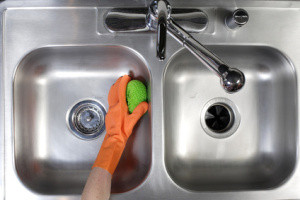 A 2011 study done by the National Science Foundation International (NSF) spotlighted 10 of the most germ-laden places in homes. After studying 22 families who each swabbed 30 specific items in their home, they discovered that 6 of the 10 most contaminated spots reside in the kitchen. That’s right…the heart of the home where you cook and eat with your loved ones is crawling with kitchen germs. In this post, we will focus on those six germ locations that reside in your kitchen.
A 2011 study done by the National Science Foundation International (NSF) spotlighted 10 of the most germ-laden places in homes. After studying 22 families who each swabbed 30 specific items in their home, they discovered that 6 of the 10 most contaminated spots reside in the kitchen. That’s right…the heart of the home where you cook and eat with your loved ones is crawling with kitchen germs. In this post, we will focus on those six germ locations that reside in your kitchen.
Sponges
The number one most infected item in most homes is “loaded with coliforms, yeast and mold, total bacteria…even some staphylococcus,” Robert Donofrio, PhD described on Fox News. He’s talking about the household sponge. When you think about it, this isn’t too surprising. We use our sponges to wipe down dishes, tables and countertops. What’s the point in cleaning if we’re just replacing the mess with even more bacteria? Be smart about it. If you’re going to use a sponge, the NSF recommends cleaning your wet sponge frequently by placing it in the microwave for two minutes once per day, and replacing every two weeks or more as needed. You may even want to replace your sponge with dishcloths, towels and rags as they can be sanitized easily in your washing machine’s hot cycle.
Sinks and Faucets
The Kitchen sink was found to have the second highest concentration of microorganisms out of the swabbed items. Once again, this is a place that stays moist and is often missed in the cleaning process.
If you’re thinking about installing a new sink with your upcoming renovation, you may want to incorporate a stainless steel basin, as they are easily sanitized; or even a copper sink which has natural antibacterial properties. In addition, wash and disinfect your sink 1 or 2 times per week with disinfectant and attack the drain with a mixture of water and bleach.
While on the subject of sinks, the NSF study also placed faucet handles in the rankings, holding un-pleasantries such as coliform bacteria as well as yeast and/or mold. Make sure not to miss faucets, knobs and handles in your disinfecting ritual.
Coffee Reservoir
When is the last time you cleaned your coffee reservoir? If you can’t remember, that isn’t a good sign as the NSF pegged it as the fifth germiest place. The reservoir is damp and dark, harboring bacteria, mold and mildew. Make sure you read up on the manufacturer’s recommended cleaning instructions. You’ll want to clean your coffee reservoir at least once a month.
Countertops and Cutting Boards
Unfortunately, countertops also made the naughty list. Coliform bacteria were found on the countertops of 30% of the homes tested. This isn’t too surprising considering the foods that are commonly prepared on the countertop – not to mention the sponge that runs across frequently with its toxins. Coliform can be found in many food items including unwashed produce as well as poultry and other meat. Not surprisingly, cutting boards also made the list. These are visited by the same foods as countertops, so make sure you wash them thoroughly after every use.
If you are planning to replace your countertops, quartz would be a great non-porous option that doesn’t need to be sealed. Stainless steel countertops were found to have one of the least amounts of microorganisms left after cleaning, according to a study done by the Hospitality Institute of Technology. People often think that granite countertops harbor bacteria due to their porous nature, but if you clean regularly and seal your granite countertop every 1-3 years, you shouldn’t have a problem.
Kitchens are often the most beautiful rooms of homes and are frequented by many, so make sure you take all precautions to keep yours in tip top condition…even when viewed under a microscope.
Getting ready to remodel?

Recent Comments